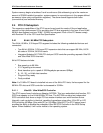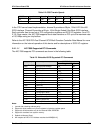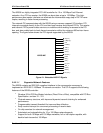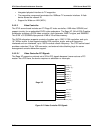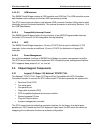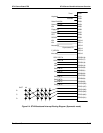
STL2 Server Board Architecture Overview STL2 Server Board TPS
2-16
2.5.1.1 Serial Ports
Two 9-pin connectors in D-Sub housing are provided for serial port A and serial port B. Both
ports are compatible with 16550A and 16450 modes, and both are re-locatable. Each serial
port can be set to one of four different COM-x ports, and each can be enabled separately.
When enabled, each port can be programmed to generate edge- or level-sensitive interrupts.
When disabled, serial port interrupts are available to add-in cards.
2.5.1.2 Parallel Port
The STL2 baseboard provides a 25-pin parallel port connector. The SIO provides an IEEE
1284-compliant 25-pin bi-directional parallel port. BIOS programming of the SIO registers
enables the parallel port and determines the port address and interrupt. When disabled, the
interrupt is available to add-in cards.
2.5.1.3 Floppy Port
The FDC in the SIO is functionally compatible with floppy disk controllers CMOS 765B and
82077AA. The baseboard provides the 24- MHz clock, termination resistors, and chip selects.
All other FDC functions are integrated into the SIO, including analog data separator and 16-
byte FIFO.
2.5.1.4 Keyboard and Mouse Connectors
The keyboard controller is functionally compatible with the 8042A. The keyboard and mouse
connectors are PS/2-compatible.
2.5.1.5 Real-time Clock
The PC97317VUL contains an MC146818-compatible real-time clock with external battery
backup. The device also contains 242 bytes of general purpose battery-backed CMOS RAM.
The real-time clock provides system clock and calendar information stored in non-volatile
memory.
2.5.1.6 Plug-and-Play Functions / ISA Data Transfers
The PC97317VUL contains all signals for ISA compatible interrupts and DMA channels. It also
provides ISA control, data, and address signals to transfer data to/from the BMC and the BIOS
flash device. This ISA subsystem transfers all SIO peripheral control data to the IB6566 South
Bridge as well.
2.5.1.7 Power Management Controller
The PC97317VUL component contains functionality that allows various events to allow the
power-on and power-off of the system. This can be from PCI Power Management Events, the
BMC, or the front panel. This circuitry is powered from stand-by voltage, which is present
anytime the system is plugged into the AC outlet.



